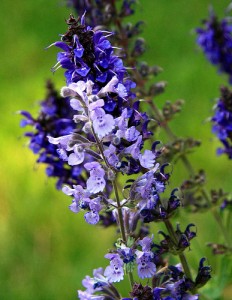Drought-tolerant gardening is a more important skill than ever, due to our steadily warming climate, decreasing water supplies, and our need to be  resilient. Plus, growing things is joyful, and builds community because we end up talking with our neighbors while we’re gardening. They can also be less work and create lower water bills than needier, higher-maintenance lawns and gardens.
resilient. Plus, growing things is joyful, and builds community because we end up talking with our neighbors while we’re gardening. They can also be less work and create lower water bills than needier, higher-maintenance lawns and gardens.
As an admitted biophile [lover of life-forms in general] who gets lots of compliments on my gardens, I’ll give some tips here on growing beautiful things with little water. A true xeriscape has only drought-tolerant plants, and I don’t pretend to have that. But we ousted our lawns years ago and replaced them with gardens. This did not exactly save water since we had refused to ever water our lawns when we had them. Water is surprisingly costly in Portland, plus it’s ironically green to sport a brown lawn here. ![]() But our yards are all about fruits, vegetables, and flowery, drought-tolerant treasures like sage and catmint (pictured). We have no sprinkler system; we water just by hand.
But our yards are all about fruits, vegetables, and flowery, drought-tolerant treasures like sage and catmint (pictured). We have no sprinkler system; we water just by hand.
- If this is new to you, be willing to experiment by first creating a drought-tolerant section of your garden, or replacing part of your lawn with water-thrifty plants.
- Choose the right plants for your xeriscape. Here is a partial list: Lavender and other Mediterranean species; geraniums; the salvia family; tall and bunch grasses including blue fescue; succulents like hens-and-chicks. More here. My sage (salvia family) and catmint, both drought-tolerant, are blooming like gangbusters right now.
- Use the best quality soil you can, because good soil with lots of organic matter holds water much better than poor or tired soil. We amend our soil whenever we plant anything; this season I’m using a potting mix called Waterhold cocoblend that’s designed for water conservation.
- If you really need a sprinkler system, use drip hoses. The gadgets that fling water through the dry air are evaporating lots of water into that air that will never reach your plants.
- Scoop little bowls in the soil around the base of each plant to hold water. When you water it, the water should be going into the ground, not running away from the plant. Water heading down your sidewalk or into your street means you can be doing better, for sure.
- Water deeply, directly onto the root systems, and not too often, early in the morning or in the evening. Deep watering helps plants to grow deep roots. Young plants need more frequent watering than older, well-established plants.
- Mulch! Mulching is the most powerful thing we can do to protect our soil and all the valuable, living microorganisms in it from the punishing summer sun. To mulch, lay a carpet of shredded bark or leaves, fine gravel, straw or grass clippings down all around your xeriscape.
- If any plant is water-stressed, do not fertilize it. Hydrate the plant thoroughly and let it recover before introducing any food; otherwise, the fertilizer will ‘burn’ the plant.
- Trim and prune as a steady habit; in general, the less excess growth a plant has, the less water it needs to support that growth.
- Have I mentioned the importance of mulching? It suppresses weeds as well as conserves water, and less time spent on weeding means more time for creating bouquets from our beautiful drought-tolerant flowers.
Related Posts:
- None Found


 Subscribe
Subscribe
No Comments so far ↓
There are no comments yet...Kick things off by filling out the form below.